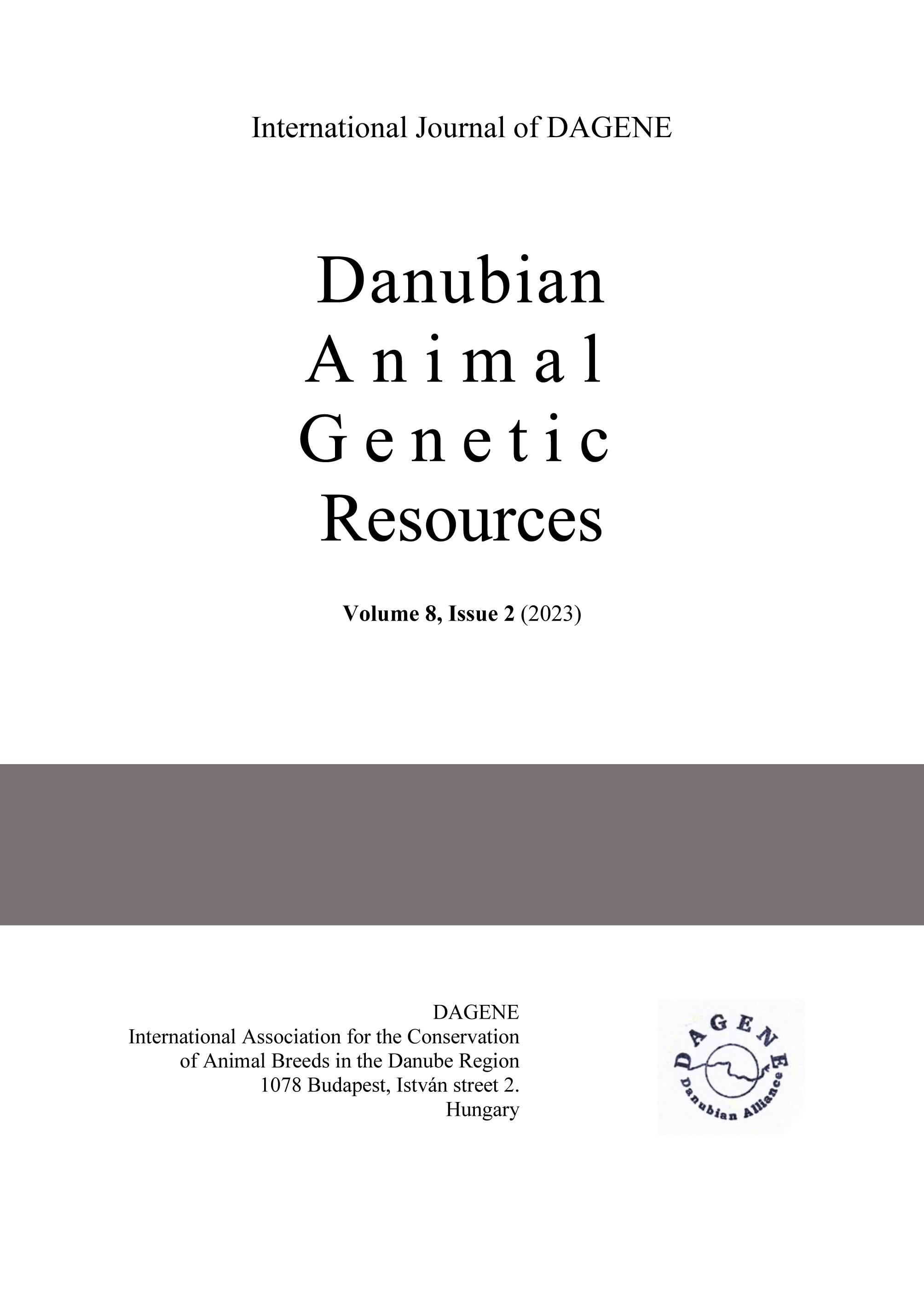Testing of microsatellite markers for individual identification of fallow deer
Abstract
The fallow deer (Dama dama) of Hungary has excellent value to our country due to its game meat and antler trophies. As an attempt to aid law enforcement against illegal activities, such as poaching, illegal trading, and in other cases like traffic accidents, we aimed to develop a genetic marker set suitable for individual identification. During our research, 28 microsatellite markers on 15 fallow deer samples from two different populations were tested. Four microsatellites were found to be polymorphic, each with two or three alleles. Based on our current results, Hungarian fallow deer populations show low genetic diversity. This is in agreement with previous studies conducted on the species and is probably a direct result of the species’ past extinction from the most of Europe during the Pleistocene and later its human-mediated reintroduction to most of its current range. The low number of polymorphic markers presents the need to include additional markers.fallow deer
References
BAKER, K. – GRAY, H. – RAMOVS, V. – MERTZANIDOU, D. – AKIN PEKŞEN, Ç. – BILGIN, C. – SYKES, N. – HOELZEL, R. (2017): Strong population structure in a species manipulated by humans since the Neolithic: the European fallow deer (Dama dama dama). Heredity 119:16-26. https://doi.org/10.1038/hdy.2017.11
DE OLIVEIRA, E.J.F. – GARCIA, J.E. – CONTEL, E.P.B. – DUARTE, J.M.B. (2005): Genetic Structure of Blastocerus dichotomus Populations in the Paraná River Basin (Brazil) Based on Protein Variability. Biochem Genet 43:211–222. https://doi.org/10.1007/s10528-005-5212-9
ELEK B (2019): The criminalization of poaching in Hungary. Zbornik radova Pravnog fakulteta, Novi Sad 53:639–648. https://doi.org/10.5937/zrpfns53-20330
FRANK, K. – SZEPESI, K. – BLEIER, N. – SUGÁR, L. – KUSZA, Sz. – BARTA, E. – HORN, P. – OROSZ, L. – STÉGER, V. (2022): Genetic traces of dispersal and admixture in red deer (Cervus elaphus) populations from the Carpathian Basin. Eur J Wildl Res 68:55. https://doi.org/10.1007/s10344-022-01602-w
JONES, K.C. – LEVINE, K.F. – BANKS, J.D. (2000): DNA-based genetic markers in black-tailed and mule deer for forensic applications. California Fish and Game 86:115–126
LORENZINI, R. – FANELLI, R. – TANCREDI, F. – SICLARI, A. – GAROFALO, L. (2020): Matching STR and SNP genotyping to discriminate between wild boar, domestic pigs and their recent hybrids for forensic purposes. Sci Rep 10:3188. https://doi.org/10.1038/s41598-020-59644-6
MÁRQUEZ, A. – MALDONADO, J.E. – GONZÁLEZ, S. – BECCACECI, M.D. – GARCIA, J.E. – DUARTE, J.M.B. (2006): Phylogeography and Pleistocene demographic history of the endangered marsh deer (Blastocerus dichotomus) from the Río de la Plata Basin. Conserv Genet 7:563–575. https://doi.org/10.1007/s10592-005-9067-8
MEREDITH, E. – ADKINS, J. – RODZEN, J. (2019): UrsaPlex: An STR multiplex for forensic identification of North American black bear (Ursus americanus). Forensic Sc. Int Genet 44:102161. https://doi.org/10.1016/j.fsigen.2019.102161
MEREDITH, E.P. – RODZEN, J.A. – LEVINE, K.F. – BANKS, J.D. (2005): Characterization of an additional 14 microsatellite loci in California Elk (Cervus elaphus) for use in forensic and population applications. Conserv Genet 6:151–153. https://doi.org/10.1007/s10592-004-7735-8
OLIVEIRA, E.J.F. – GARCIA, J.E. – DUARTE, J.M.B. – CONTEL, E.P.B. (2008): Development and characterization of microsatellite loci in the marsh deer (Blastocerus dichotomus Cervidae). Conserv Genet 10:1505. https://doi.org/10.1007/s10592-008-9769-9
PÁDÁR, ZS. – KOVÁCS, G. – NOGEL, M. – CZEBE, A. – ZENKE, P. – KOZMA, ZS. (2019): Genetika és bűnüldözés – Az igazságügyi célú DNS-vizsgálatok első negyedszázada Magyarországon. I. Belügyi Szemle 67(12):7-34. https://doi.org/10.38146/BSZ.2019.12.1
PÁDÁR, ZS. – KOVÁCS, G. – NOGEL, M. – CZEBE, A. – ZENKE, P. – KOZMA, ZS. (2020): Genetika és bűnüldözés – Az igazságügyi célú DNS-vizsgálatok első negyedszázada Magyarországon II. Belügyi Szemle 68(1):9-32. https://doi.org/10.38146/BSZ.2020.1.1
PÁDÁR, ZS. – KOVÁCS, G. – NOGEL, M. – POÓR, S.V. – ZENKE, P. (2022): The catalyst-like role of forensic genetics in the developmental process of Hungarian wildlife forensics. Forensic Sci Int Genet Supplement Series 0: https://doi.org/10.1016/j.fsigss.2022.10.056
PÁDÁR, ZS. – NOGEL, M. – KOVÁCS, G. – GÁRDONYI, G. – ZENKE, P (2022): A vadvilági bűnözés sajátos kriminalisztikai kihívásai Magyarországon. Belügyi Szemle 70(9):1727-1748. https://doi.org/10.38146/BSZ.2022.9.1
SIM, Z. – MONDERMAN, L. – HILDEBRAND, D. – PACKER, T. – JOBIN, R.M. (2021): Development and implementation of a STR based forensic typing system for moose (Alces alces). Forensic Sci Int Genet 53:102536. https://doi.org/10.1016/j.fsigen.2021.102536
SINGH, A. – GAUR, A. – SHAILAJA, K. – SATYARE BALA, B. – SINGH L. (2004): A novel microsatellite (STR) marker for forensic identification of big cats in India. Forensic Sci Int 141:143–147. https://doi.org/10.1016/j.forsciint.2004.01.015
SZABOLCSI, Z. – EGYED, B. – ZENKE, P. – PÁDÁR, Z. – BORSY, A. – STEGER, V. – PÁSZTOR, E. – CSÁNYI, S. – BUZAS, Z. – OROSZ L (2014): Constructing STR multiplexes for individual identification of Hungarian red deer. J Forensic Sci 59:1090–1099. https://doi.org/10.1111/1556-4029.12403
ZENKE, P. – EGYED, B. – PÁDÁR, ZS. (2017): A vadászható fajok védelme: az orvvadászat bizonyíthatósága az igazságügyi genetika segítségével: Eseti alkalmazások. MÁL 139(10):631-639. http://hdl.handle.net/10832/2754
ZENKE, P. – EGYED, B. – PÁDÁR, ZS. – KOVÁCS, G (2015): Increasing relevance of non-human genetics in Hungarian forensic practice. Forensic Sci Int Genet. Supplement Series 5:e250-e252. https://doi.org/10.1016/j.fsigss.2015.09.100
ZENKE, P. – EGYED, B. – ZÖLDÁG, L. – PÁDÁR, ZS (2011): Population genetic study in Hungarian canine populations using forensically informative STR loci. Forensic Sci Int Genet 5(1):e31-e36. https://doi.org/10.1016/j.fsigen.2010.03.013



